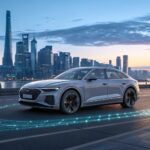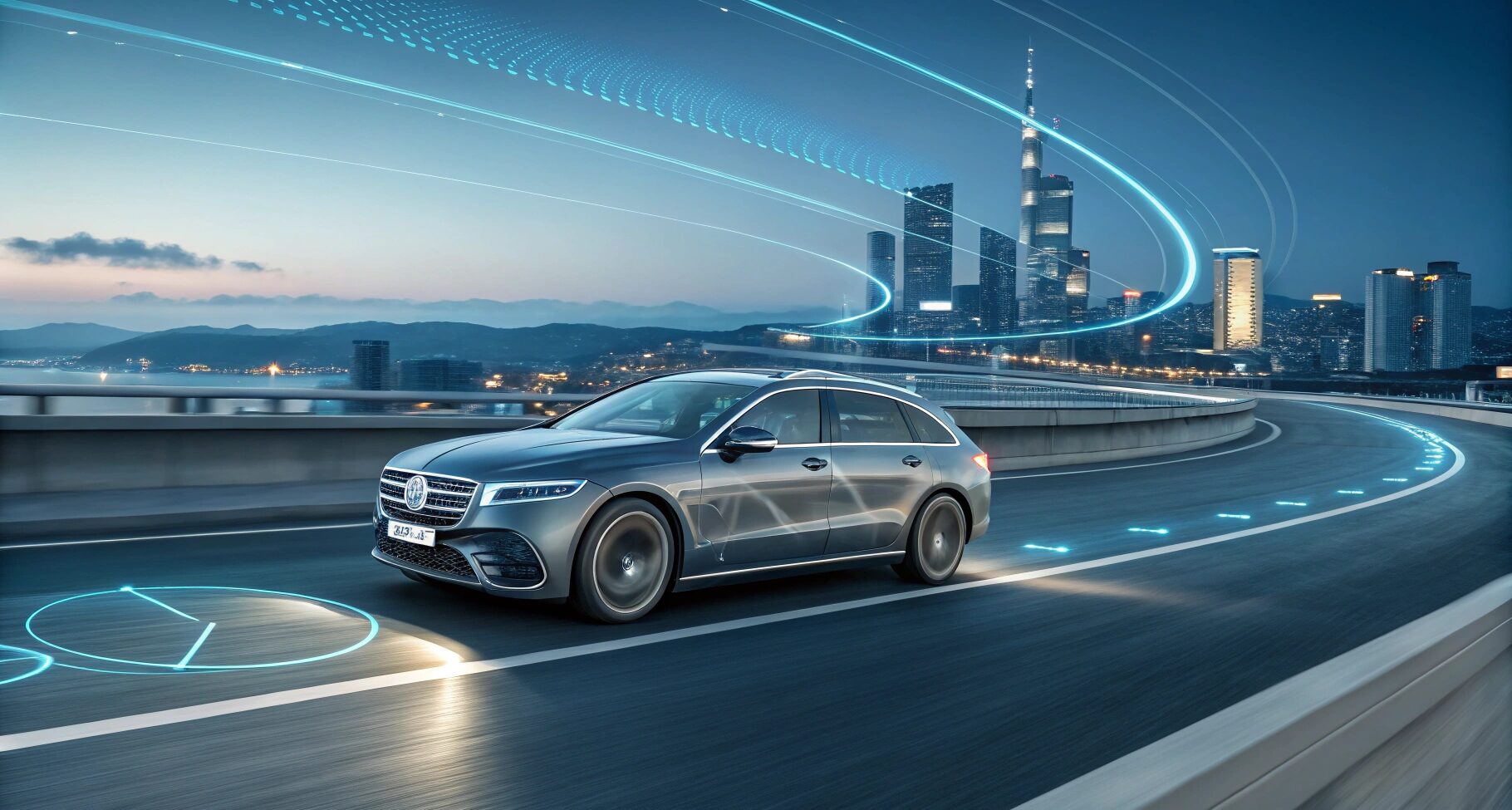
Automotive Artificial Intelligence: Shaping the Future of Smart Vehicles
Imagine a car that anticipates your needs, navigates effortlessly through traffic, and keeps you safer than ever before. This isn’t science fiction; it’s the reality shaped by automotive artificial intelligence. The integration of AI isn’t just an incremental improvement; it’s a fundamental transformation. It redefines how we interact with vehicles. This includes enhancing safety and efficiency, and also revolutionizing convenience and autonomy. This article will explore how automotive artificial intelligence is fundamentally changing our interaction with vehicles, from safety and efficiency to convenience and autonomy, and its profound implications for the future trends of AI in cars.
What is Automotive Artificial Intelligence?
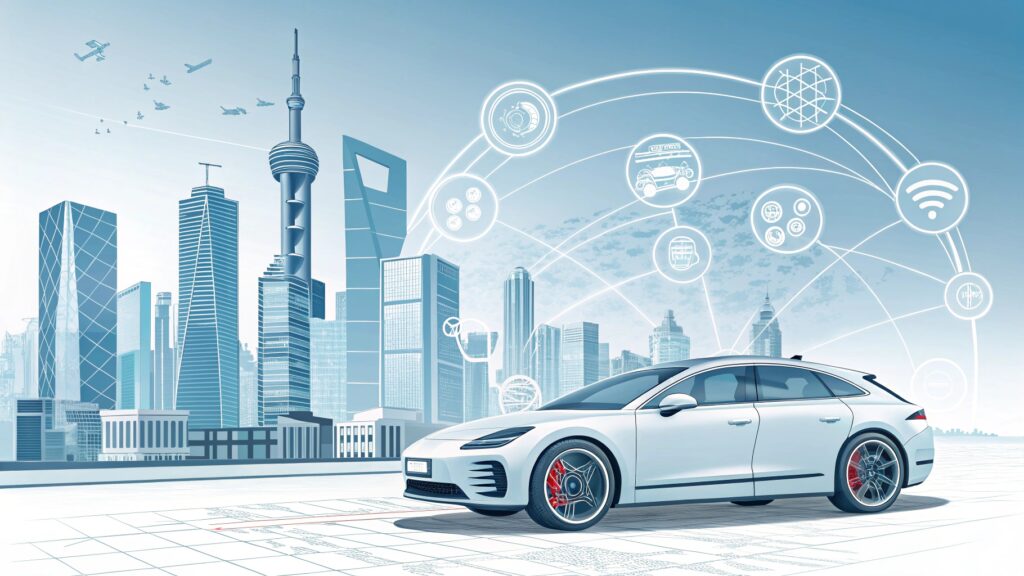
At its core, automotive artificial intelligence refers to applying AI technologies within vehicles and the broader automotive ecosystem. It encompasses a range of advanced capabilities that allow cars to perceive, process, learn, and make intelligent decisions, often without direct human involvement. This goes far beyond the simple electronic systems of the past; AI-powered vehicles are designed to learn from data, adapt to changing conditions, and execute complex operations.
Automotive artificial intelligence relies on several key technological components:
- Sensors: These are the “eyes and ears” of the AI system. They collect vast amounts of real-time data from the vehicle’s surroundings. This includes cameras for visual perception, radar for distance and speed detection, lidar for precise 3D mapping, and ultrasonic sensors for short-range object detection.
- AI Algorithms: This is the “brain” that processes the raw data from sensors. Algorithms, particularly those based on machine learning and deep learning, enable the vehicle to recognize objects, understand road conditions, predict pedestrian movements, and interpret complex scenarios.
- Processors: Powerful onboard computers are essential for real-time data processing and decision-making, ensuring instantaneous reactions to dynamic driving environments.
- Actuators: These are the systems that execute the AI’s decisions, such as steering, braking, acceleration, and even adjusting climate control or infotainment.
AI-powered systems differ significantly from traditional vehicle electronics because of their ability to learn and adapt. Traditional systems are programmed for specific tasks. Conversely, AI systems analyze new data, identify patterns, and continuously improve their performance. This leads to more sophisticated and nuanced decision-making. The global AI in automotive industry projects significant growth, potentially reaching an estimated $48.59 billion by 2034. This underscores its rapid adoption and transformative potential (Precedence Research, 2025).
What are the Applications of AI in Modern Cars?
AI in the automotive industry isn’t just about self-driving cars; its applications are incredibly diverse. They enhance nearly every aspect of the driving experience and vehicle operation.
Enhanced Safety and Driver Assistance
One of the most immediate and impactful applications of automotive artificial intelligence is in safety. Advanced Driver-Assistance Systems (ADAS) use AI to help prevent accidents and reduce driver fatigue. Examples include:
- Adaptive Cruise Control (ACC): AI adjusts the vehicle’s speed to maintain a safe distance from the car ahead.
- Lane Keeping Assist (LKA) and Lane Departure Warning (LDW): These systems use cameras and AI to detect lane markings. They then warn or assist the driver in staying within their lane.
- Automatic Emergency Braking (AEB): AI-powered sensors detect potential collisions with other vehicles, pedestrians, or cyclists. They can automatically apply the brakes if the driver doesn’t react in time.
- Blind Spot Monitoring (BSM): AI analyzes sensor data to alert drivers to vehicles in their blind spots.
- Driver Monitoring Systems: AI can detect signs of driver fatigue or distraction (e.g., drowsiness, looking away from the road). It then issues warnings to enhance safety.
Infotainment and User Experience
AI is transforming the in-car experience, making vehicles more personalized and intuitive.
- Voice Assistants: Natural Language Processing (NLP) allows drivers to control navigation, music, calls, and climate settings using voice commands. This minimizes distractions.
- Personalization: AI learns driver preferences. It automatically adjusts seat positions, mirror settings, climate control, and even music playlists.
- Predictive User Interfaces: AI can anticipate driver needs. It suggests destinations or displays relevant information based on routines or external factors like traffic.
Vehicle Performance and Efficiency
AI also plays a crucial role in optimizing vehicle performance and maintenance. This is particularly relevant as we move towards ai car technology 2025 and beyond.
- Predictive Maintenance: AI-driven health monitoring systems analyze real-time data from onboard sensors. They detect early warning signs of mechanical issues before they escalate into costly failures. This proactive approach reduces downtime and extends component lifespan (XenonStack, 2025).
- Optimized Energy Management: For electric and hybrid vehicles, AI algorithms optimize battery usage, charging cycles, and power distribution. This maximizes range and efficiency.
- Traffic Prediction and Route Optimization: AI-powered navigation systems use real-time traffic data, weather conditions, and historical patterns. They then suggest the most efficient routes, saving time and fuel.
Manufacturing and Design
Beyond the vehicle itself, AI revolutionizes design and manufacturing processes. It leads to increased efficiency, reduced costs, and higher quality. Digital twin technology, for example, allows manufacturers to create virtual models of vehicles and parts, enabling cost-effective testing and optimization before physical production (Simplilearn, 2025).
How Do AI-Powered Driver Assistance Systems Work?
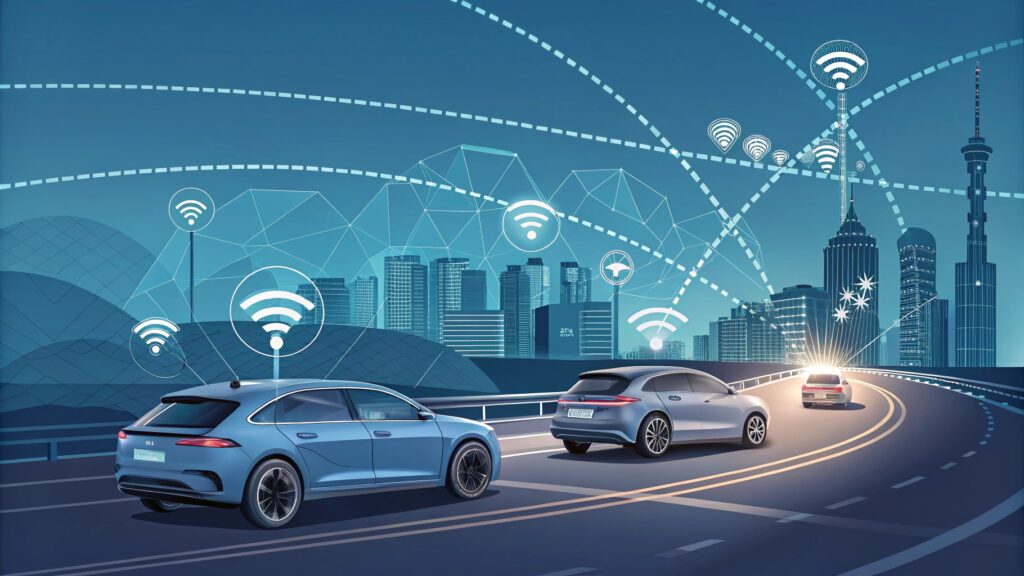
AI-powered driver assistance systems are at the forefront of automotive innovation. They act as a crucial bridge to fully artificial intelligence for autonomous vehicles. These systems operate through a sophisticated interplay of sensors, data processing, and intelligent decision-making.
The core of ADAS functionality is sensor fusion. This involves combining data from multiple types of sensors. The goal is to create a comprehensive and robust understanding of the vehicle’s surroundings. For instance:
- Cameras: These provide visual data. They identify lane markings, traffic signs, other vehicles, pedestrians, and obstacles. AI uses computer vision techniques to interpret these images.
- Radar: This technology emits radio waves. It detects the presence, distance, and speed of objects, even in adverse weather conditions.
- Lidar: Lidar uses laser pulses to create highly detailed 3D maps of the environment. It offers precise distance measurements and object recognition, especially effective in complex scenarios.
- Ultrasonic Sensors: These are commonly used for short-range detection, such as in parking assist systems.
Once the data is collected, AI algorithms perform perception. This involves:
- Object Detection and Classification: AI identifies and categorizes various elements in the vehicle’s environment. These include cars, trucks, motorcycles, pedestrians, bicycles, and traffic cones.
- Lane Detection: Algorithms identify road lanes and their boundaries.
- Scene Understanding: AI processes the overall context of the driving environment. It recognizes intersections, highway exits, and complex urban settings.
The perceived information then feeds into the decision-making layer. Here, AI models, often leveraging deep learning, analyze the current situation and predict potential future events. For example, if a pedestrian is detected entering the vehicle’s path, the AI quickly calculates the probability of a collision. Based on these calculations, the AI system determines the appropriate action—whether to issue a warning, apply the brakes, or initiate a steering maneuver.
What are the Challenges of Integrating AI in Automotive?
While automotive artificial intelligence offers immense potential, its integration also presents significant challenges. These challenges span technical, ethical, and regulatory domains.
Technical Challenges
- Data Management: AI systems require vast amounts of high-quality data for training and operation. Collecting, storing, processing, and annotating this data from diverse sources (sensors, real-world driving scenarios, simulations) is incredibly complex. Data fragmentation, heterogeneity, and quality issues can hinder effective AI development (Controlar, 2023).
- Computational Power: Real-time AI processing within a vehicle demands extremely powerful, yet energy-efficient, onboard computing capabilities. This necessitates advanced chip design and optimization, with companies like NVIDIA and Tesla developing specialized processors for automotive AI applications (Mordor Intelligence, 2025).
- Sensor Limitations: Advanced as they are, sensors can still face limitations. These occur in extreme weather conditions (heavy rain, snow, dense fog) or challenging lighting scenarios, which can impact AI perception.
- Software Complexity and Validation: Developing robust, reliable, and secure AI software for safety-critical automotive applications is an enormous undertaking. Ensuring the software performs flawlessly in countless unpredictable real-world scenarios requires extensive validation and testing.
- Cybersecurity: As cars become more connected and reliant on AI, they also become potential targets for cyberattacks. Protecting these systems from malicious intrusion and ensuring data integrity is paramount.
Ethical and Societal Challenges
- Safety and Liability: One of the most pressing ethical concerns revolves around determining responsibility in the event of an accident involving an AI-driven vehicle. Who is at fault: the manufacturer, software developer, or vehicle owner? The “trolley problem” is a classic thought experiment that highlights the moral dilemmas AI might face in unavoidable accident scenarios, requiring complex ethical frameworks for decision-making (Indika AI, 2025).
- Privacy Concerns: Connected cars AI technology generates vast amounts of data about vehicle occupants, their movements, and preferences. Ensuring the secure collection, storage, and ethical use of this sensitive data, while adhering to privacy regulations like GDPR, is a significant challenge.
- Job Displacement: The rise of artificial intelligence for autonomous vehicles could lead to job displacement for professional drivers (truck drivers, taxi drivers). This raises societal questions about economic impact and workforce retraining.
- Public Trust and Acceptance: Overcoming skepticism and building public confidence in AI-powered vehicles is crucial for widespread adoption. This requires transparency in AI decision-making and a demonstrated track record of safety.
Regulatory Challenges
- Developing Legal Frameworks: Existing automotive regulations were not designed for autonomous vehicles. Governments worldwide are grappling with establishing new legal frameworks for testing, deployment, and liability of AI-powered cars. International harmonization of these regulations is also a significant hurdle (Number Analytics, 2025).
- Standardization: Establishing industry-wide standards for AI safety, performance, and data exchange is vital for interoperability and consumer confidence.
Addressing these challenges requires a collaborative effort among automakers, tech companies, governments, and the public. This ensures that automotive artificial intelligence evolves responsibly and benefits society as a whole.
Which Companies Are Leading in Automotive AI Development?
The race to dominate automotive artificial intelligence is highly competitive. Both established automakers and innovative tech giants are making significant strides. The landscape for ai car technology 2025 is shaped by key players and strategic partnerships.
Traditional Automakers
Many legacy automotive manufacturers are investing heavily in AI, often through dedicated divisions or collaborations:
- Tesla: A pioneer in electric vehicles, Tesla is also renowned for its advanced AI systems, particularly Autopilot and Full Self-Driving (FSD) capabilities. They heavily leverage vision-only AI and neural networks trained on billions of miles of real-world driving data. This allows them to make real-time decisions, from lane changes to obstacle avoidance (Acropolium, 2025).
- Mercedes-Benz: Mercedes-Benz has achieved significant milestones with its DRIVE PILOT system. This offers Level 3 conditional automated driving in certain regions. It allows the driver to disengage from driving tasks under specific conditions.
- General Motors (Cruise): GM’s Cruise subsidiary is a leader in autonomous ride-hailing services. They deploy fully autonomous vehicles in select cities.
- BMW, Audi, Toyota, and others: These companies continuously advance their ADAS offerings. They also develop their own proprietary autonomous driving technologies. They often focus on a layered approach combining different sensor types.
Tech Giants & Startups
Technology companies and specialized startups are bringing their AI expertise to the automotive sector:
- Waymo (Google): Widely regarded as a frontrunner in fully autonomous driving, Waymo has accumulated millions of self-driven miles. They focus on Level 4 (high automation) and Level 5 (full automation) capabilities. Their platform combines sensor fusion with AI-based perception and path planning to navigate complex urban environments (Acropolium, 2025).
- NVIDIA: A key enabler of automotive artificial intelligence, NVIDIA provides powerful AI computing platforms (like the DRIVE platform) and software for autonomous vehicles. Their chips are crucial for processing the massive amounts of data required by AI algorithms.
- Mobileye (Intel): A leader in vision-based ADAS and autonomous driving solutions, Mobileye’s technology is integrated into vehicles from numerous global automakers. They specialize in computer vision and mapping technologies.
- Emerging Players: Numerous innovative startups contribute to specific areas of automotive AI. Examples include EllaMotors (personalized vehicle recommendations), SpatialGPT.AI (immersive selling solutions), and Zyplow (insurance fraud detection), among others (StartUs Insights, 2025). These companies drive niche advancements and new business models within the ai in automotive industry.
The future of automotive artificial intelligence is increasingly characterized by collaboration. Traditional automakers are partnering with tech companies to leverage their AI expertise. Meanwhile, tech giants are seeking automotive partners to scale their solutions. This synergy accelerates the development and deployment of advanced artificial intelligence for autonomous vehicles and other smart car technologies.
What is the Impact of AI on Electric and Hybrid Vehicles?
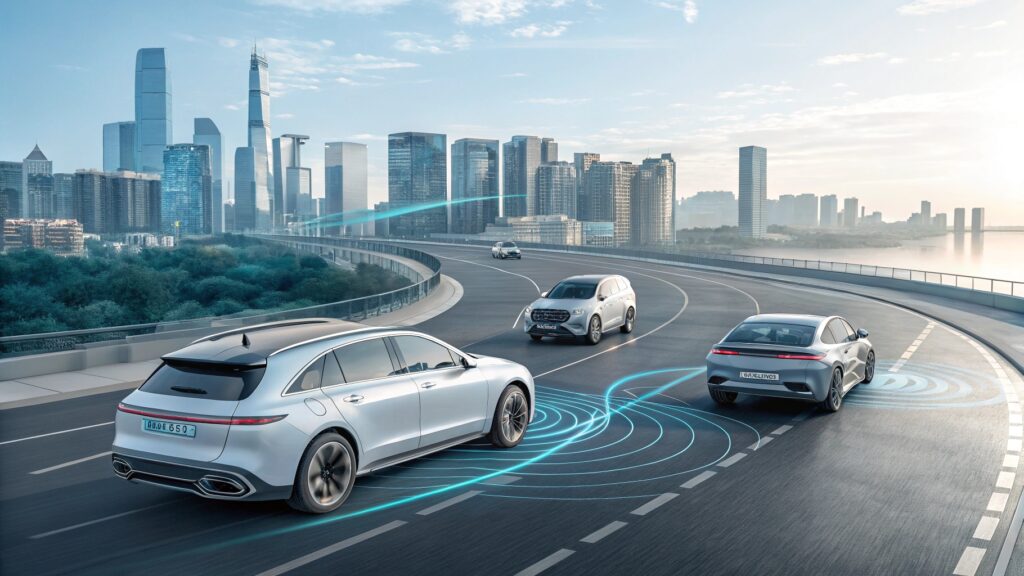
Automotive artificial intelligence profoundly impacts electric vehicles (EVs) and hybrid vehicles. It plays a critical role in optimizing their performance, extending their range, and enhancing their overall user experience. This influence is a significant aspect of the future trends of AI in cars.
Optimized Battery Management
One of AI’s most crucial contributions to EVs and hybrids is in Battery Management Systems (BMS). AI algorithms are used to:
- Predict Battery Degradation: By analyzing vast datasets of battery performance, charging cycles, and environmental conditions, AI can accurately predict battery health and degradation over time. It optimizes charging strategies to prolong battery lifespan (Oxford Academic, 2025).
- Maximize Range and Efficiency: AI intelligently manages power distribution. This ensures energy is used as efficiently as possible across various driving conditions. It optimizes energy flow between the battery, motor, and other vehicle systems to extend range.
- Optimize Charging: AI can learn charging patterns and adapt to grid conditions. This potentially enables smart charging solutions that leverage off-peak electricity rates or balance grid demand.
Intelligent Route Planning and Range Anxiety Mitigation
AI-powered navigation systems in EVs and hybrids go beyond simple shortest-path calculations. They consider:
- Real-time Energy Consumption: AI accounts for factors like terrain, driving style, traffic congestion, and weather. This provides highly accurate range estimates.
- Charging Infrastructure: The system integrates data on charging station availability, charger types, and charging speeds into route planning. This effectively mitigates “range anxiety” for EV drivers.
- Dynamic Route Adjustment: AI can dynamically adjust routes based on real-time traffic and energy usage. It recommends alternative paths that optimize energy consumption.
Regenerative Braking Optimization
AI fine-tunes regenerative braking systems. These convert kinetic energy during deceleration into electrical energy to recharge the battery. AI algorithms optimize how aggressively or smoothly regenerative braking is applied. This maximizes energy recovery based on driving conditions and driver preferences.
Predictive Maintenance for EV Components
Just as with conventional vehicles, AI enhances predictive maintenance for electric and hybrid powertrains. AI identifies potential issues in:
- Electric Motors: It detects subtle anomalies in motor performance or unusual vibrations.
- Inverters and Converters: It monitors the health of these crucial power electronics.
- Charging Systems: It predicts potential faults in charging ports or internal charging units. This proactive maintenance reduces the risk of breakdowns, extends component life, and lowers overall ownership costs.
Seamless Integration and Accelerated Adoption
Ultimately, AI enhances the overall experience and performance of electric and hybrid vehicles. It makes them more attractive and user-friendly. From smarter energy management to more reliable operation, AI accelerates the adoption of these greener transportation solutions. It significantly contributes to the evolving connected cars AI technology landscape and broader environmental sustainability goals.
Future Outlook: The Road Ahead for Automotive AI
The journey of automotive artificial intelligence has just begun. As technology continues to evolve, we can anticipate even more transformative changes. These will redefine mobility as we know it and shape the future trends of AI in cars.
Emerging Trends
- Vehicle-to-Everything (V2X) Communication: This critical component of connected cars AI technology will enable vehicles to communicate seamlessly. They will communicate with each other (V2V), with infrastructure (V2I like traffic lights), with pedestrians (V2P), and with the cloud (V2C). This interconnectedness will facilitate safer roads, optimized traffic flow, and smarter city integration. AI will process this deluge of V2X data to make real-time, collective decisions.
- Personalized In-Car Experiences: Beyond current personalization, future AI assistants will be more sophisticated. They will offer proactive support, adaptive interfaces, and even emotional intelligence. They will cater to occupants’ moods and needs. Cars could become true extensions of our digital lives.
- AI-driven Design and Manufacturing: AI’s role in vehicle production will deepen. This includes greater automation, predictive quality control, and the use of generative AI for designing new vehicle components and structures. This will further streamline the development cycle and reduce costs (Appventurez, 2025).
- Sustainability: AI will play an increasing role in creating more sustainable vehicles. This ranges from optimizing material usage in manufacturing to enabling eco-friendly driving patterns and more efficient energy grids for EVs.
- Integration with Smart Cities: Artificial intelligence for autonomous vehicles will be a cornerstone of smart cities. Here, intelligent traffic management, optimized public transportation, and efficient emergency services will be orchestrated by AI. This reduces congestion and pollution (ResearchGate, 2025).
Long-Term Vision: The AI Car Technology 2025 and Beyond
The long-term vision for ai car technology 2025 and beyond is widespread autonomous driving. It will be deeply integrated into daily life. Cars may transition from personal ownership to vast, interconnected AI-driven fleets. Vehicles will become mobile AI platforms. They will offer not just transportation, but also entertainment, productivity, and connection to a broader smart ecosystem.
The automotive industry stands at the precipice of a revolution. This revolution is driven by the relentless innovation in automotive artificial intelligence. The transformation extends beyond how we drive. It impacts how cars are designed, manufactured, and maintained. It also affects how they integrate into our cities and our lives.
Conclusion: Driving Towards an Intelligent Future
Automotive artificial intelligence undeniably shapes the future of smart vehicles. It moves us closer to an era of safer, more efficient, and more connected transportation. We have explored how AI provides fundamental definitions and powers a myriad of applications in modern cars. This ranges from critical safety features like advanced driver-assistance systems to enhancing in-car experiences and optimizing vehicle performance, particularly for electric and hybrid models. While significant challenges remain in terms of technology, ethics, and regulation, the relentless pace of innovation, fueled by leading companies and strategic collaborations, indicates a clear path forward.
The impact of AI in the automotive industry is not just an enhancement; it is a fundamental shift. It transforms vehicles into intelligent, adaptive entities. The future trends of AI in cars point towards a future where cars are seamlessly integrated into smart cities through connected cars AI technology. They offer personalized experiences and contribute to a more sustainable world. As we continue to develop sophisticated artificial intelligence for autonomous vehicles and refine ai car technology 2025, we are not just building better cars. We are driving towards an entirely new paradigm of mobility, making our roads safer, our journeys smarter, and our urban environments more harmonious. The intelligent future of transportation is no longer a distant dream, but a rapidly approaching reality, fueled by the power of automotive artificial intelligence.
Read Our Another Blog: https://industrifyai.com/how-ai-in-automotive-is-transforming-car-design-and-safety-standards/
